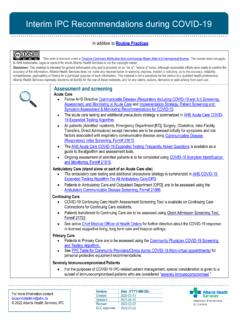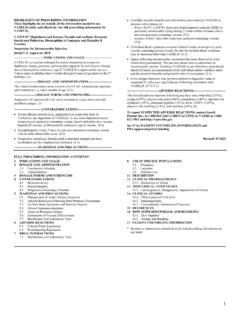Transcription of Lithium Battery Safety, Handling, and Storage
1 Lithium Battery safety , handling , and Storage STPS-SOP-0018 Version 1 August 2015 Risk Factor: 1 This document applies to the following locations: DEN CHC PTH McM SP PAL NBP LMG Prepared for the National Science Foundation, Division of Polar Programs by Lockheed Martin ASC Contract #NSFDACS1219442 Lithium Battery Storage , handling , and safety STPS-SOP-0018 Version 1 Aug 2015 Version History Version # Date Section (if applicable) Author/Editor Change Details 1 Aug 2015 All Jamee Johnson Dean Hancock New document The document library holds the most recent versions of all documents.
2 Approved by: All brand and product names remain the trademarks of their respective owners. This publication may also contain copyrighted material, which remains the property of respective owners. Permission for any further use or reproduction of copyrighted material must be obtained directly from the copyright holder. Page i Lithium Battery Storage , handling , and safety STPS-SOP-0018 Version 1 Aug 2015 Table of Contents Purpose .. 1 Authorities and Mandates .. 1 Risk Factor .. 1 Applicability .. 1 Responsibilities.
3 1 Peninsula Implementation Manager .. 1 Hazardous Materials Specialist .. 1 Peninsula 1 Marine Laboratory Technician .. 2 Palmer Assistant Lab Supervisor .. 2 Electronic Technicians .. 2 Waste Technician .. 2 Background .. 2 Lithium Cell Types .. 2 Primary or Non-Rechargeable Metallic Lithium Cells .. 2 Secondary or Rechargeable Lithium Ion Cells .. 2 Cell handling Procedures .. 3 Cell Storage .. 4 Assembling Battery Packs .. 4 Battery Shipment .. 5 Emergency Procedures .. 5 Releases from Cells (Vented, Leaked or Exploded).
4 5 Hazards .. 6 Emergency Actions .. 6 handling a Hot Cell .. 6 Fire .. 7 Lithium (Primary, Non-Rechargeable) Batteries .. 7 Lithium Ion (Secondary, Rechargeable) 7 Lithium Battery Fire Extinguisher Selection .. 7 First Aid procedures .. 8 Clean up Procedures (for qualified/trained personnel) .. 8 Waste Concerns .. 9 References .. 9 Records .. 9 Appendices .. 10 Glossary .. 10 Page ii Lithium Battery Storage , handling , and safety STPS-SOP-0018 Version 1 Aug 2015 List of Tables Table 1: Lithium Battery Fire Extinguisher Selection.
5 8 Table 2: Records .. 9 Page iii Lithium Battery Storage , handling , and safety STPS-SOP-0018 Version 1 Aug 2015 Purpose This document will serve as guideline for the safe handling , use, and Storage of Lithium batteries in the United States Antarctic Program (USAP). Authorities and Mandates This document has been created to satisfy recommendations of NSF SLEP inspectors, JMS Naval Architects and Salvage Engineers, pursuant to RVSS and NSTM555. Recommendations in this document are based on Woods Hole Oceanographic Institution, safety document SG-10, and UNOLS Lithium Battery safety circular May 2012.
6 Pursuant to 49 CFR all shipments of hazardous materials must comply with packaging regulations based on recommendations made by the United Nations. Fines and penalties for non-compliance can be substantial. Risk Factor This procedure is assigned a risk factor of 1. Lithium batteries can be dangerous, and their handling and Storage should be done with care. Applicability This document is applicable to USAP Peninsula support, including Palmer Station and the Research Vessels. These include the Nathaniel B Palmer (NBP) and the Lawrence M Gould (LMG).
7 Responsibilities The following responsibilities are assigned as indicated: Peninsula Implementation Manager The Peninsula Implementation Manager will be responsible for primary development of this program and identification of hazardous materials that are being shipped to Palmer Station or the Research Vessels. Hazardous Materials Specialist The Hazardous Materials Specialist will review this document and will assist in identifying Lithium Battery hazards in the program. Peninsula Logistics Peninsula Logistics personnel will make sure that all shipments of Lithium Batteries include proper SDS documentation and Dangerous Goods declarations.
8 Page 1 Lithium Battery Storage , handling , and safety STPS-SOP-0018 Version 1 Aug 2015 Marine Laboratory Technician The Marine Lab Technician will properly store and handle batteries on the research vessels, and review safety information with grantees and Edison Chouest crew. Palmer Assistant Lab Supervisor The Palmer Assistant Lab Supervisor will properly store and handle batteries at Palmer Station, and review safety information with grantees and emergency teams at Palmer Station. Electronic Technicians Will follow safety procedures when assembling Battery packs and handling batteries.
9 Waste Technician Will review document, follow departmental procedures for cleaning up and disposing of hazardous waste. Background Lithium Cell Types There are two types of Lithium Battery cells in common use: Primary or Non-Rechargeable Metallic Lithium Cells Primary Lithium batteries feature high energy density and long shelf life. They are generally used for smoke alarm, LED lighting and outdoor devices. However they are not rechargeable and totally different than Li-Ion batteries. These cells are constructed with metallic Lithium .
10 The metallic Lithium in a non-rechargeable primary Lithium Battery is a combustible alkali metal that self-ignites at 352 F, and when exposed to water or seawater reacts exothermically and releases hydrogen. Secondary or Rechargeable Lithium Ion Cells Rechargeable secondary cells utilize Lithium ions that are intercalated into graphite, Lithium metal oxides and or Lithium salts. There is no metallic Lithium in a Lithium ion Battery . Lithium ion cells prefer partial discharge to deep discharge, so it's best to avoid completely discharging the Battery .



